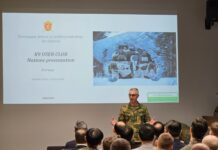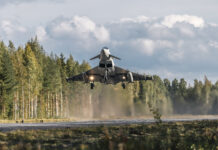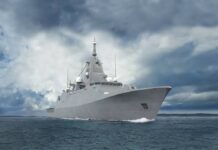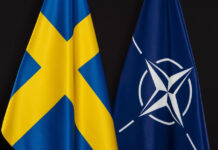Separated by a 1,300 km long border, Finland has lived with the permanent presence of its Russia neighbour Russia for decades. But unlike other European nations that share similiar airs pace environments, neutral or non-aligned Finland is not a NATO member. However, Finland is a member of the European Union and one of NATO’s Enhanced Opportunities Partners. Together with its Baltic neighbour Sweden, however, Helsinki has searched increased political proximity to the Alliance in recent years, while the Finnish Government is still balancing a fine line between membership and Putin’s empire. Against this background, the 5,5 million nation’s leadership is close to deciding on a considerable US$ 10Bn renewal of its fleet of fighter aircraft.
During the Cold War, Finland was as a border state between the West and the USSR. In exchange for staying neutral, Russia did not meddle with Finnish domestic affairs and along walking that fine line, the Finnish Air Force (Ilmavoimat or FINAF) introduced Western-built aircraft (Folland GNAT, Fouga MAGISTER, BAE HAWK), Eastern makes (MiG-15, MiG-21) and neutral ones (Saab DRAKEN). During the 1990s, when Russia and NATO maintained a more peaceful relationship, Finland stayed remarkably distant. The manpower of the military was not reduced and conscription was maintained. Finland believes in a strong military, of which the Finnish Air Force (FINAF) is a crucial element.
Under its current Commander MajGen Pasi Jokinen, the service branch today has approximately +2,000 uniformed and civilian personnel, in addition to accepting approximately 1,400 conscripts annually. In case of a national crisis, there is a reserve force of around 38,000 available. Of course, the FINAF monitors Finland’s air space on a 24/7 basis. Long and medium-range surveillance radars that were acquired in 1988 are now being upgraded and other sensors generate a situational picture covering Finland’s territory and adjacent areas. With the perception of a though graduated, but more or less continuous threat from Russia, air-defence plays a major role in the FINAF‘s philosophy and activities of the Russian military in the Baltic area are subject to permanent observation.
Finnish HORNETS
In 1992, Finland ordered 64 F-18C/D HORNETs which were delivered between 1996 and 2000. These were not initially designated F/A-18s as they did not have a ground-attack capability. In a standing quick-reaction-alert rotation, these continue to serve with two units: Lapland Air Command’s Fighter Squadron 11 at Rovaniemi Air Base and Karelia Air Command’s Fighter Squadron 31 at Kuopio-Rissala Air Base. A third unit, Satakunta Air Command’s Air Combat Centre also operates some F/A-18s at Tampere-Pirkkala Air Base. A third unit, the Air Combat Centre, also operates some F-18s at Tampere-Pirkkala. If the need arises to adjust the readiness level either in peace time or in the event of a crisis, aircraft may be dispersed to road bases and other remote operating locations. In a crisis, the Air Force shifts the focus on defensive counter-air fighter missions and air defence C2 – for all three Finnish services.
Since their service introduction, these legacy aircraft – 55 single- and seven two-seaters – have received two major upgrades between 2006 and 2010 and between 2012 and 2016. Carried out with scheduled maintenance-terms at Patria’s Halli facility, the first upgrade (MLU1) was to revamp the aircraft’s air-to-air capability, which involved the integration of a helmet-mounted sighting system and the AIM-9X SIDEWINDER IR-guided missile. MLU2, the second mid-life upgrade, subsequently enabled the integration of a wide range of air-to-air and air-to-ground capabilities. The air-to-ground weapon suite includes the Joint Direct Attack Munition (JDAM) precision-guided bomb, the AGM-154 gliding Joint Stand-Off Weapon (JSOW) medium-range glide bomb and the powered AGM-158A Joint Air-to-Surface Stand-off Missile (JASSM) 270 km-range standoff-missile (70 systems). The LITENING electro-optical targeting-pod was also introduced, together with modern self-protection, communication and information distribution-systems. Nevertheless and beside all efforts, the FINAF legacy F-18 fleet – after 30+ years of operations – is nearing the end of its service life by 2030.
Finnish HAWKs
On 16 December 1980, the first of 50 BAE-HAWK Mk.51 jet-trainers (HW302) arrived in Pori and assumed the role of a ‘flying classroom’ to prepare pilots for the fast jet cockpit. In 1993, seven additional HAWK Mk.51A were acquired and in 2007, a batch of 18 former Swiss Air Force HAWK Mk.66, with a quite low number of flight hours and with analogue cockpits, complemented the fleet. These were upgraded with new avionics and, in some cases, with two-way datalinks, with the support of BAE Systems at PATRIA Aviation between 2011 and 2013. As a result from this upgrade the entire frontline HAWK Mk.51 fleet of 32 aircraft upgraded with glass-cockpits will be part of the FINAF fleet until the mid-2030s. Currently no new LIFT-trainer is therefore pursued. Kauhava was the homebase for the FINAF jet-training school, but in 2014, all HAWKs – two former Swiss aircraft were lost in 2013 – were transferred to Tikkakoski were the Air Force Acadamy is located. The Kauhava airfield and garrison were handed over to a private owner. The aircraft remain to be a crucial element of the FINAF’s training concept. Throughout Europe the type is well known via the FINAF display team, the MIDNIGHT HAWKS. The Finnish Air Force celebrated the 40th anniversary of the Hawk in Finnish service in December 2020.
Other Valuable Assets
Today, the Air Force Academy is currently transitioning from Valmet L-70 VINKA basic trainers to 28 German-built Grob 115s that formerly served in the RAF as “tutors” and were acquired via Babcock Aerospace. Like the HAWKs, they were modernised before entry into service between 2016 and 2018. Before entering service, they received an avionics- and communication-systems upgrade with state-of-the art digital displays and a cockpit-layout compatible with the other aircraft operated by the FINAF. Since 2005, preliminary and basic pilot training services have been contracted to PATRIA. As a strategic partner of the Finnish Air Force, PATRIA is responsible for aircraft and engine heavy maintenance, repairs, upgrades, structural modifications and system development.
Medium airlift capability is provided by three Airbus (CASA) C-295M tactical airlifters, although one of them is used as an ELINT- (Electronic Intelligence) and COMINT- (Communication Intelligence) platform. On 12 February 2018, the FINAF announced that Lockheed Martin’s DRAGON SHIELD system was now operational on the aircraft. Lockheed Martin modified this Airbus C-295 cargo aircraft to accommodate the containerised roll-on-roll-off surveillance system. The Finnish Defence Forces were also provided with ground stations and communication terminals to support the airborne system. In addition, there are three Learjet-35s, used for light transport, photography, air sampling and maritime surveillance duties. Last but not least, six Pilatus PC-12NGs are covering light personnel- and cargo-missions. All three types are operated by the Satakunta Wing at Tampere-Pirkkala Air Base. To cover pre-planned heavy-lift needs connected to scheduled deployments, the Finnish MoD has a share in NATO’s Multinational Heavy Airlift Wing (SAC) at Papá/Hungary, providing global strategic airlift for humanitarian, disaster relief and peacekeeping-missions in support of EU, UN and NATO (PfP) with three C-17s since 2009.
With respect to helicopters, all rotary wing assets were transferred to the Finnish Army Aviation (Suomen Maavoimat) at the end of the 1990s. After replacing ex-Soviet Mi-8s in 2010, the 20 NH90-TTHs (Tactical Transport Helicopter) ordered in 2001 and introduced between 2008 and 2015, are the main type of Utti Jaeger Regiment’s Helicopter Battalion. In addition, the Army operates seven Hughes MD500 light helicopters.
Exercises and Cooperation
In recent years, Finland and Sweden have deepened their bilateral defence cooperation. In 2018, the two Nordic countries signed a Memorandum of Understanding on defence cooperation. Finland and Sweden aim to boost their defence capabilities and their ability to conduct joint operations together, ultimately increasing security and maintaining stability in the Baltic Sea region and the High North. Both nations’ air forces have participated in each other’s main air operations exercises, focused on national defence, already since 2016. Politicians from both nations are keen to foster a closer military relationship, because of Russia’s increasingly aggressive posture in or over the Baltic in recent years – resulting in various encounters with pairs of armed Su-27s (once twice a day) and various Russian multi-engine platforms. There is also the perspective of fostering stronger working relationship with third parties, specifically with NATO. Every second year since 2013, Finland, Sweden and Norway have co-hosted the Arctic Challenge Exercise (ACE), which has attracted a lot of participants from several nations. In 2021, Norway is the lead nation.
In addition to Finnish F/A-18s, Rovaniemi Air Base currently hosts German EUROFIGHTER and US KC-135s participating in ACE21. In 2019, Ruska 19, the Finnish Air Force’s annual main air operations exercise involved 4,500 personnel (including ~2,000 reservists) and up to 28 F/A-18C/Ds and 14 HAWKs. The Swedish Air Force participated with eight JAS 39C/D GRIPENs and an S100 ARGUS AEW&C aircraft. Missions were flown primarily out of the Tampere, Kuopio, Rovaniemi and Jyväskylä air bases. Aircraft were also dispersed to temporary bases, established at the airports of Halli, Joensuu, Kajaani, Oulu, Pori and Vaasa. The Swedish aircraft operated from Kuopio in Finland and Luleå in Sweden.
HX Programme
Despite the economic pain generated by the COVID-19 pandemic, Helsinki has increased its annual defence budget by 54 per cent to US$4.88Bn to prepare for the initial costs of replacing the legacy F-18C/D fleet in the scope of the so-called HX-programme (H = HORNET, the letter X is typically used to indicate a candidate for replacement). Based the latest BAFO bids (Best-and-Final-Offers) submitted by 30 April 2021, Helsinki is expected to make a final decision for new fighters at a value of €9Bn later in the year. The MoD and the FINAF have received US-backed bids for the Lockheed Martin F-35A LIGHTNING II and Boeing’s F/A-18E/F Block-III SUPER HORNET and EA-18G GROWLER, as well as offers from three European companies: Dassault’s RAFALE F4 from France, the multinational EUROFIGHTER consortium offering a Tranche-4-like TYPHOON (with the UK in the lead) and Sweden with the Saab JAS 39E GRIPEN. Saab is also offering two GlobalEye AEW&C multi-mission aircraft.
In January 2020, a so-called HX Challenge was carried out at Pirkkala Air Base in central Finland, with tests performed under Finnish winter conditions in order to verify data previously supplied by the manufacturers. During two weeks of testing, the contenders flew 40 missions and also participated in simulated exercises to display their capability in operating in combat scenarios as part of Finland’s defence system. Subject to the demonstrations were sensor-ranges, as well as their resolution and ability to maintain tracking while targets used manoeuvring or employed countermeasures. They also served to determine the workload and speed associated with preparing the weapon system to attack a ground target and – in case of a long-range attack – employing standoff weapons if the aircraft can be provided with more specific target-data by a datalink. The sorties were also used to measure each of the fighters’ capability to identify and locate electronic signals and produce situational awareness of the target area. Saab sent the two-seat GRIPEN NF demonstrator and a GRIPEN E trial aircraft equipped with IRIS-T and METEOR-missiles and an electronic attack jammer pod, while a GlobalEye took part in separate trials in the south of Finland. The other bidders sent various single- and two-seat aicraft from operational USAF, USN, French and RAF-wings. Finnish media reported, that only two of the four expected USAF F-35 arrived for evaluation, one of which promptly broke down and could not participate in the tests.
Coinciding with the BAFO deadline, the four contenders released statements and held online-media-briefings to support their pitches, with some promising industrial-participation packages of varying degrees that would boost job growth in Finland. Like before in Switzerland, however, Dassault did not release statements along this line. The magazine Air Force Technology reported that Dassault had offered Finland the ability to operate the aircraft independently from France and potentially build the airframes in country. For a general regional economic as well as security-policy-related dimension, Sweden’s bid for the GRIPEN E is especially notable. Not only is Saab proposing only fully combat-capable single-seaters in denial of the need of a national OCU, the country’s top officials have publicly assisted Saab’s Campaign Director Magnus Skogberg in making the paramount case for extending the Sweden-Finland alliance into a de-facto singular operational air space covered by GRIPEN-type aircraft that commanders could use interchangeably across both nations to ward off an invasion. Boeing rightfully points to far reaching commonalities with the FINAF’s legacy HORNETs while offering meaningful long-term opportunities for the Finnish industry, associated with options for the next-generation, multi-role F/A-18E/F Block III and the unique EW warrior EA-18G GROWLER, according to a Boeing spokesman. He stressed that (what also applies to the requirement in Switzerland): “You could have a HORNET flying today and a SUPER HORNET flying tomorrow, while around 60 per cent of existing HORNET tooling can be used to support a new SUPER HORNET – (thus) increasing potential cost savings.”
Lockheed Martin touted the advanced capabilities of its F-35, dangling the prospect of offering high-tech job opportunities in Finland that “no other competitor can offer,” Bridget Lauderdale, F-35 Programme Vice President and General Manager, said in a statement. The company also says it is offering the most affordable jet, “a fifth-generation fighter at the cost of a fourth-generation aircraft. Our production work will continue for more than 20 years, and the F-35 sustainment work will continue into the 2050s – not only will Finland support its own F-35s, but it will directly support the global fleet of F-35s through the production of major components.” Obviously. Finnish analysts can be expected to check all this with a fine comb. The industrial participation obligation for HX is set at 30 per cent minimum of the total contract value.
BAE Systems, speaking on behalf the EUROFIGHTER consortium, announced that if Finland were to select their aircraft, “80 packages of in-country work for Finnish companies would be generated. The Government will influence the future programme and product, ensuring the aircraft is tailored exactly to Finnish requirements. With 570 aircraft delivered across Europe and Middle-East, the TYPHOON will remain the backbone of Europe’s combat air capability for decades to come.“ Finland was also invited to join the UK’s ECRS Mk.2 AESA-radar programme, bringing Finnish expertise into its future development. However the FINAF may wish to receive a mature AESA.
Other Interesting Aspects
Finland wants fully combat-capable fighters and therefore places a considerable lot of emphasis on the aircraft’s ordnance. The Saab offer includes several weapons systems, including MBDA’s METEOR, IRIS-T, SPEAR and KEPD350/TAURUS. TYPHOON also comes with SPEAR, MBDA’s AIM-132 ASRAAM, METEOR BVRAAM and the STORM SHADOW air-launched cruise missile. In case Finland selects either the SUPER HORNET or the F-35A, their – US-Government backed – offer includes a modern version of the AMRAAM, the AIM-120C-8, as mentioned during a media conference at the US Embassy in Helsinki in late May. This is quite a step up from the FINAF‘s current C-7, though how much exactly would come along remained unclear. Most likely the C-8 is a re-named -D, the weapon responsible for the recent test that the USAF described as “the longest known air-to-air missile kill.“ Exact ranges are obviously both classified while depending on a number of launch parameters. Also coming along from the US in the near future is the AIM-260 JATM (Joint Advanced Tactical Missile). While “commercial details” made it impossible to include that with the BAFO-bids, it looks like a rather progressive development timeline that will see the JATM overtake AMRAAM in production by the mid-2020s. The US Navy will be the first to integrate it on F/A-18E/Fs – and it is no secret that the FINAF has expressed to stay as close as possible to the standard of the main operator of any fighter they buy.
A strike-weapon expected to handle the long-range strike-mission could be the Lockheed-Martin made missile formerly known as JASSM-XR. It would provide a significant increase in range in comparison to the current range of 370 km of the AGM-158A. The JASSM-ER/ AGM-158ERB2’s range is quoted to be 1,852 km. In a combat environment, these stand-off weapons would unlock more strike-planning options, including guaranteed stand-off range against all Russian air defences (current and likely planned), as well as the possibility to re-route time-critical flight paths of the cruise missiles around hostile defences.
The EW Capability Aspect
A charming factor constituted by Boeing’s inclusion of the EA-18G GROWLER in its proposal, is that the dedication of the platform to electronic attack brings not only the computing power of the specified EW processor unit (kind of an armament element itself), but also the dedicated second crew member. When a new or previously unidentified signal is encountered, it can be processed in flight, assigning an identifier to it. When the aircraft lands, the new SIGINT result can be downloaded ready for the threat library. Boeing is believed to offer this capability as an exclusive. But while the complete absence of “hands-off” black boxes and total independence on the mission is a main selling point of the European contenders, Boeing takes a somewhat different approach – out of necessity. The SIGINT-data would be owned by the Finnish Government, but the processing of acquired mission data is easiest to handle through US infrastructure, where Finnish personnel can be negotiated to be embedded at key functions. EW aspects were also subject to a controversial discussion between the two US contenders at the aforementioned media briefing at the US Embassy.
Georg Mader












